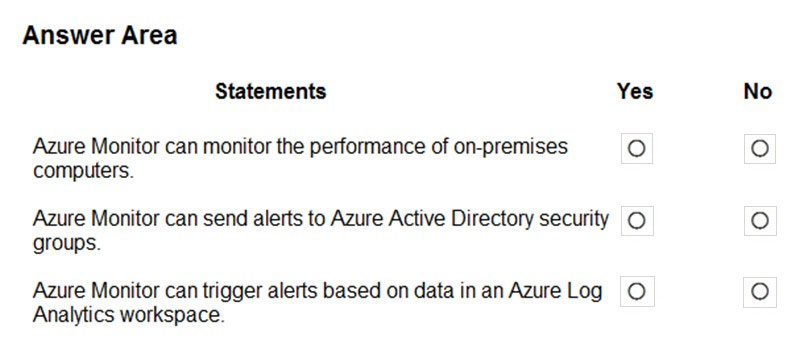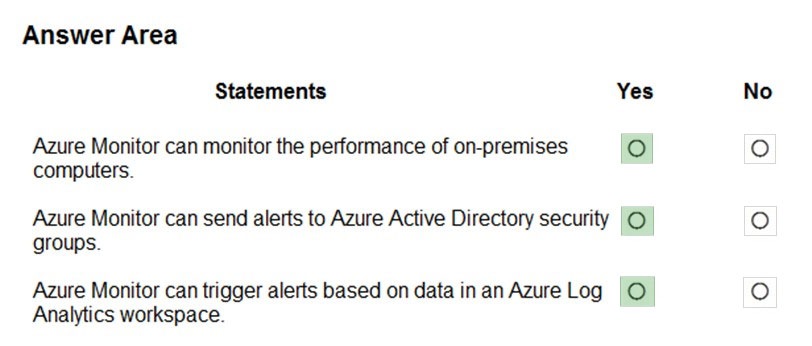HOTSPOT -
For each of the following statements, select Yes if the statement is true. Otherwise, select No.
NOTE: Each correct selection is worth one point.
Hot Area:

HOTSPOT -
For each of the following statements, select Yes if the statement is true. Otherwise, select No.
NOTE: Each correct selection is worth one point.
Hot Area:


Box 1: Yes -
Azure Monitor maximizes the availability and performance of your applications and services by delivering a comprehensive solution for collecting, analyzing, and acting on telemetry from your cloud and on-premises environments.
Box 2: Yes -
Alerts in Azure Monitor proactively notify you of critical conditions and potentially attempt to take corrective action.
Box 3: Yes -
Azure Monitor uses Target Resource, which is the scope and signals available for alerting. A target can be any Azure resource. Example targets: a virtual machine, a storage account, a virtual machine scale set, a Log Analytics workspace, or an Application Insights resource.
References:
https://docs.microsoft.com/en-us/azure/azure-monitor/overview https://docs.microsoft.com/en-us/azure/azure-monitor/platform/alerts-overview
I think first answer is YES: https://docs.microsoft.com/en-us/azure/azure-monitor/overview I think second answer is NO. Azure Monitor cannot send alerts (email) to Azure AD security group but only to Azure AD user: https://docs.microsoft.com/en-us/azure/azure-monitor/platform/action-groups. I think last answer is YES: https://docs.microsoft.com/en-us/azure/azure-monitor/platform/alerts-overview
I Agree
Email will only be sent to Azure AD user members of the role. Email will not be sent to Azure AD groups or service principals. You're very correct
Just try it ! From Azure Portal create an azure active directory security group. From Azure Monitor create an action group and select either of the two. The First won't let you specify a name of an AD Security Group, only roles The Second forces you to add specific emails (individuals or generic) but NO AD Security Group. So Second Answer is NO, and if MS says it's yes, then it should rewrite the question because the wording is misleading.
Thanks bud. When are you taking the test?
To Add more weight Second answer is NO. A security group can have users, devices, groups and service principals as its members and users and service principals as its owners https://docs.microsoft.com/en-us/azure/azure-monitor/alerts/action-groups . Notification type: Select the type of notification you want to send. The available options are: Email Azure Resource Manager Role - Send an email to users assigned to certain subscription-level ARM roles. Email/SMS/Push/Voice - Send these notification types to specific recipients. So it's either a role for the resource (like Owner) or an individual BUT NO GROUPS !
Answer is Y-N-Y - https://docs.microsoft.com/en-us/azure/azure-monitor/overview - https://docs.microsoft.com/en-us/azure/azure-monitor/platform/action-groups - https://docs.microsoft.com/en-us/azure/azure-monitor/platform/alerts-overview
YYY. I wrote my exam a few minutes ago and I passed! I highly recommended exam topics🤌
Yes Yes Yes
Correct Y Y Y. Showed up in 11-16-22 test. A few questions on Azure Monitor's extension, Azure Insight, as well. Scored 955.
Appeared in my test 10/30/23 I answered Y-Y-Y. Not sure about it. Final Score was 895 "describe Azure management" was 81% and "describe Azure arch" was 92%
All of the statements are correct. Azure Monitor can monitor the performance of on-premises computers. You can use Azure Monitor to monitor the performance and availability of your on-premises servers, as well as the performance of your applications and services running on those servers. This can help you identify and troubleshoot issues, and ensure that your on-premises systems are running smoothly. Azure Monitor can send alerts to Azure Active Directory security groups. You can configure Azure Monitor to send alerts to one or more Azure AD security groups when certain conditions are met. This can help you ensure that the right people are notified when there are issues with your systems. Azure Monitor can trigger alerts based on data in an Azure Log Analytics workspace. You can use Azure Monitor to set up alerts that are triggered when specific data is logged to an Azure Log Analytics workspace. This can help you identify issues and trends in your data, and take appropriate action in response.
Got Feb 10, 2022
ANS : Y-Y -Y https://docs.microsoft.com/en-us/windows/security/identity-protection/access-control/active-directory-security-groups Like distribution groups, security groups can be used as an email entity. Sending an email message to the group sends the message to all the members of the group.
#2 YES. Active Groups... so the security group stated can be the action group
Y,Y,Y For the second question: The answer is Y. https://learn.microsoft.com/en-us/training/modules/describe-monitoring-tools-azure/4-describe-azure-monitor
No There is noting mentioned about alerts send to AD group
2nd one is Y. in the setting, you can specify email address. It can be a email address of mail-enabled security group, therefore Yes.
Was on exam 26/02/2022
is sending alerts equals to sending emails?
Yes. Azure Monitor can monitor the performance of on-premises computers using Log Analytics agent. No. Azure Monitor alerts are not sent to Azure Active Directory (AAD) security groups. They are typically sent via email, SMS, push notification, or ITSM tools. Yes . Azure Monitor can trigger alerts based on data in Azure Log Analytics workspace.
in addition to monitoring your on-prems, Azure Mon can both send and trigger alerts
Y,N,Y Send email to the members of the subscription's role. Email will only be sent to Azure AD user members of the role. Email won't be sent to Azure AD groups or service principals. A notification email is sent only to the primary email address. Source1: https://docs.microsoft.com/en-us/azure/azure-monitor/alerts/action-groups#email-azure-resource-manager-role Source2: https://docs.microsoft.com/en-us/learn/azure-fundamentals/monitoring-fundamentals/media/2-identify-product-options-01.png Source3: https://docs.microsoft.com/en-us/learn/modules/monitoring-fundamentals/2-identify-product-options